
Mortellaro's Nursery
Shrubs, trees, ground covers, native plants, and seasonal color
Wholesale Only
Click on any of the alpha indexes below to view the corresponding lists of plants.
The default list is displayed alphabetically by common name for all plant types. You can view the plants by clicking on the Scientific Name or limit the plant type by using the drop down.
Plants actively being grown for the current season are shown -- selecting Discontinued Items will show plants we have offered in the past.
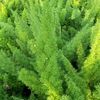
|
Fern, FoxtailBotanical Name: Asparagus densiflorus 'Meyerii'
Foxtail Fern (Asparagus densiflorus 'Meyeri') is a unique, evergreen perennial grown for its dense, bottlebrush-like plumes that resemble fluffy green foxtails. Though not a true fern, it offers a similar fine texture and performs well in shaded to partially sunny areas of the Texas landscape. Its bold shape and vivid green color make it a standout in containers, shaded borders, mass plantings, and modern tropical designs. Foxtail Fern thrives in part sun to light shade, ideally with protection from intense afternoon heat. It prefers well-drained soil and is adaptable to a range of pH levels, including slightly alkaline soils. Once established, it is drought-tolerant but benefits from occasional deep watering during extended dry spells. It tolerates poor soils, is deer-resistant, and rarely suffers from pests or diseases. It grows in a clump-forming habit to about 2 feet tall and 3 to 4 feet wide. Space plants 18 to 24 inches apart for dense coverage. In USDA Zones 9–11, Foxtail Fern remains evergreen year-round. In Zone 8, it may suffer frost damage but often regrows from the base in spring. If growing in containers in Central Texas, move them to a protected area during hard freezes. Light pruning in early spring will refresh the plant and encourage fuller growth. All parts of the plant, especially the berries, are toxic to pets and may cause gastrointestinal upset if ingested. [ More Info ]
|
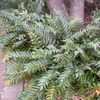
|
Fern, HollyBotanical Name: Cyrtomium falcatum
Holly Fern (Cyrtomium falcatum) is a tough, shade-loving evergreen fern valued for its glossy, holly-like fronds that bring texture and rich green color to shaded beds, woodland borders, and containers. Native to parts of Asia but well-adapted to Central and East Texas, this fern thrives in humid, protected spaces where other plants may struggle. It’s an ideal choice for low-light understory plantings, particularly where winter resilience and year-round foliage are desired. Holly Fern performs best in part to full shade and in moist, well-drained soils rich in organic matter. It is tolerant of slightly alkaline soils but does not like heavy, poorly drained clay. Once established, it is moderately drought-tolerant, though regular watering in dry periods will help maintain its appearance. Plants typically grow 18 to 30 inches tall and wide with an upright, arching habit. Space plants 18 to 24 inches apart in beds for solid coverage. A common concern among gardeners is the appearance of spores on the undersides of mature fronds—these brown or black dots are a natural part of the fern’s reproductive cycle and are not a disease or insect infestation. They often appear in symmetrical rows and are harmless. Avoid overreacting with chemical sprays or pruning unless fronds are truly damaged. In USDA Zones 7–10, Holly Fern is cold-hardy, but in harsh winters, fronds may die back and return from the roots in spring. Apply mulch in late fall to protect crowns and maintain moisture. [ More Info ]
|
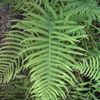
|
Fern, RiverBotanical Name: Dryopteris normalis
Fast growing Texas native fern that demands moist, well drained acidic soils throughout the spring and summer. Semi-evergreen in warmer areas, but dies back to the roots completely if temperatures drop below freezing. Leaves are a light green hue, very graceful and delicate. Spreads easily by underground runners. Although it is drought tolerant, it dies back to the roots and will only return during wet conditions. Will outright die within twelve months if the conditions do not become favorable.
[ More Info ]
|
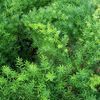
|
Fern, SprengeriBotanical Name: Asparagus densiflorus 'Sprengeri'
Open airy leaves and the light graceful form gave this plant it's name, however it is not a true fern as it self propagates by seeds and root stems. Small white flowers appear in the summer, followed by red berries that are enjoyed by birds. Turns an unsightly shade of yellow in the heat of full sun, however maintains a healthy dark green in shade. [ More Info ]
|
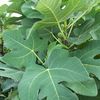
|
Fig TreeBotanical Name: Ficus carica 'Celeste'
The Celeste Fig thrives in Texas landscapes, particularly in zones 7 through 9. This deciduous tree typically reaches a mature height of 10 to 15 feet with a spread of 10 to 12 feet. The figs are sweet, small to medium-sized fruits that ripen in late summer to early fall. The tree prefers well-drained soil and does best in full sun to light shade, although it may struggle in areas with poor drainage or excessive moisture. In the landscape, a fig tree is often used as a specimen tree or in orchards. It is a great addition to small backyard gardens, providing both shade and fruit. While not typically used for mass planting, it can be planted in a group or along fences to create a hedge or summer-only privacy screen. The tree is relatively low-maintenance once established and its large, attractive leaves add interest throughout the growing season. The tree is drought-tolerant once established, though it should be watered during extended dry spells to support fruit production. Celeste Fig is non-toxic, but its sap can irritate the skin, so care should be taken when handling the tree. It is also deer-resistant, making it suitable for landscapes where wildlife may be a concern. It prefers slightly acidic to neutral soils and tolerates a variety of soil types as long as they are well-drained. When planting multiple fig trees, space them about 10 to 12 feet apart to allow for their mature spread and ensure proper airflow. One thing to note is that once a fig tree is planted, it can be difficult to remove. Fig trees often send up new shoots from the root system, making them tough to get rid of once established. In winter, Celeste Fig should be protected from harsh freezes, as it is less cold-hardy than some other fig varieties. Mulching around the base of the tree can help protect the roots and provide insulation during colder months. Pruning should be done during the dormant season to maintain the tree’s shape and remove any dead or damaged wood. [ More Info ]
|

|
Fig VineBotanical Name: Ficus pumila
A vigorous growing vine native to East Asia that has found itself useful in the southern Texas landscapes. Two types of leaves exist for the Fig Vine; the young leaves are small, no larger than one inch and are borne on young stems that do nothing more than climb any surface they touch. This, coupled with the vigorous growth habit allow Fig Vine to cover walls, trees, and even buildings relatively quickly and completely. Once the vine finds it has nothing left to climb, adult stems will emerge with larger, thicker leaves, and will also bear non-edible fig fruits. Fig Vine is very tolerant of poor soil and heat. Harsh winters can kill the vine back; otherwise pruning it constantly to keep under control will be required. Be aware of the surfaces it will come into contact with, as it will damage wood fences and brick walls if forcefully removed. If you wish to remove Fig Vine with minimal damage, destroy the plant or stems at the base and allow the foliage to decompose naturally. [ More Info ]
|
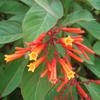
|
FirebushBotanical Name: Hamelia patens
Firebush is a tropical shrub celebrated for its fiery red-orange tubular flowers and ability to thrive in the heat, making it a perfect choice for Texas landscapes. While not native to Texas, this heat- and drought-tolerant plant is well-suited for areas with hot summers. Its flowers bloom from late spring until the first frost, providing a stunning display of color while attracting hummingbirds, butterflies, and other pollinators. The bright flowers are often complemented by its reddish-green foliage, which can deepen in color during cooler months. This fast-growing shrub prefers full sun but can tolerate partial shade, though it will produce fewer blooms in lower light. Firebush thrives in well-drained soils and adapts to both alkaline and acidic conditions, provided the soil drains effectively. It is moderately drought-tolerant once established and generally low-maintenance, requiring only occasional watering during prolonged dry spells. Firebush is non-toxic and deer-resistant, making it a versatile and worry-free addition to many landscapes. Firebush typically grows to a mature height and spread of 4 to 6 feet in North Texas but may reach up to 10 feet in frost-free areas. When planting, space individual plants 3 to 4 feet apart for hedges or mass plantings. Its natural growth habit is loosely rounded, but it can be pruned to maintain a desired shape or size. Firebush also works well in containers, where it can remain slightly smaller. However, gardeners should be mindful that Firebush is incredibly resilient—once established, it can be difficult to fully remove. Even when roots are dug up, the plant often reemerges from any fragments left behind. In winter, Firebush is sensitive to frost and may die back to the ground in areas with freezing temperatures. However, it regrows from its roots in spring if protected with a thick layer of mulch before winter arrives. In frost-free climates, it remains evergreen and can bloom year-round with proper care. [ More Info ]
|
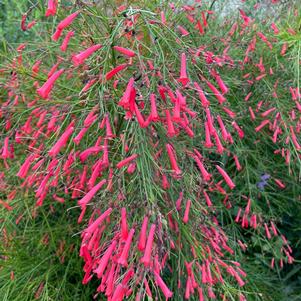
|
Firecracker FernBotanical Name: Russelia equisetiformis
Semi-evergreen perennial with clusters of scarlet tubular blooms from spring to fall. They form on the new growth of slender stems that gracefully fall over as they grow upwards, almost a fern growth habit. Appreciates regular watering and good drainage. [ More Info ]
|
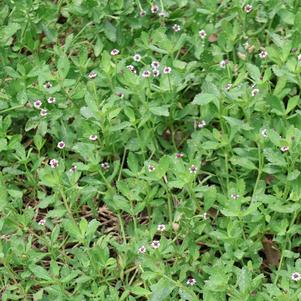
|
Frog FruitBotanical Name: Phyla nodiflora
Frog Fruit, also known as Turkey Tangle, is a fast-growing, Texas native groundcover known for its ability to thrive in tough conditions and spread quickly to form a dense, low mat. Its tiny, white-to-pinkish button-like flowers bloom spring through fall, drawing in bees, butterflies, and other pollinators, while its trailing stems root at the nodes to cover bare ground efficiently. This plant excels in full sun to part shade, and tolerates a wide range of soil types, including alkaline and compacted soils. It is one of the few low-growing groundcovers that can handle periodic flooding and poor drainage, yet also survives dry conditions once established. It is commonly used for erosion control, between stepping stones, parkways, or as a natural lawn alternative. While not suited for high foot traffic, it can tolerate light use. Frog Fruit typically stays under 4 inches tall, but spreads outward indefinitely. It can be mowed on a high setting to maintain a tidier appearance or left to sprawl for a more naturalistic effect. Spacing is not critical, as plants quickly root and fill gaps, but planting 12–18 inches apart will ensure rapid coverage. It is deer resistant, non-toxic, and safe for pets and children. Hardy in USDA Zones 7–11, Frog Fruit stays evergreen in mild winters but may brown slightly in cold snaps. It recovers quickly in spring and rarely needs protection. Light trimming in late winter can help rejuvenate thick mats or control spread. [ More Info ]
|
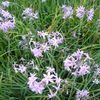
|
Garlic (Society)Botanical Name: Tulbaghia violacea
Aromatic perennial with a strong garlic-onion fragrance. Purple blooms persist spring to fall, reaching up to three feet tall.
[ More Info ]
|
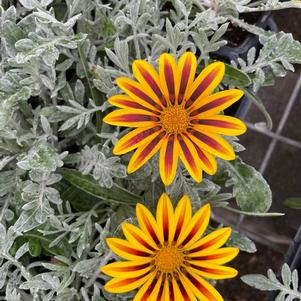
|
GazaniaBotanical Name: Gazania rigens
New for 2022, this perennial flower boast vibrant flowers that thrive in hot and dry enviroments. Cultivars for 2022 Kiss Frosty Mix - green foliage with multiple large white blooms with red and yellow streaks. [ More Info ]
|
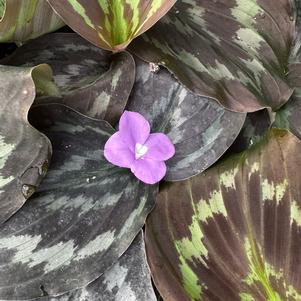
|
Ginger, PeacockBotanical Name: Kaempferia pulchra
Peacock Ginger is a low-growing, shade-loving perennial prized for its broad, patterned foliage that resembles the eyes of a peacock’s feather, and for its small but striking lavender to pink flowers that bloom intermittently from late spring into early fall. Though native to Southeast Asia, it performs well in humid, subtropical gardens, including shaded areas of Central and East Texas. It is not a Texas native, but it is well-suited to use as a groundcover in woodland gardens, beneath trees, or along shaded borders. This plant thrives in partial to full shade and prefers moist, well-drained soil rich in organic matter. While it can handle neutral to slightly acidic soil, it can tolerate light alkaline soils. Peacock Ginger is deer-resistant and generally free of pest problems. Though the flowers are subtle, the ornamental foliage is its main appeal and remains attractive throughout the warm season. Plants grow 12–18 inches tall and spread slowly through underground rhizomes to form dense mats. When spacing for coverage, plant 12–15 inches apart. Peacock Ginger is cold hardy to USDA Zone 8, meaning it will likely die back to the ground in a freeze but regrow in spring from underground rhizomes. In colder areas, a thick mulch layer over winter can help protect the roots. In Zone 7 and colder, it is often treated as a container plant or annual. [ More Info ]
|

|
Ginger, VariegatedBotanical Name: Alpinia zerumbet 'Variegata'
Variegated Ginger is a tropical-looking, ornamental perennial grown for its bold, yellow-striped green foliage that brings lush texture and vibrant contrast to shaded gardens. Though not native to Texas, it can be successfully grown in Central and South Texas landscapes as a seasonal accent or in protected microclimates. The foliage grows in dense, upright clumps and may produce small, shell-like pink and white flowers in ideal conditions, though blooms are less common in cooler climates. This plant thrives in partial shade to full shade, where it is protected from intense afternoon sun. It performs best in well-drained, organically rich, slightly acidic soil and requires consistent moisture, especially in summer. While it is not drought tolerant, it can recover well if watered thoroughly after dry periods. It does not tolerate alkaline soils or poor drainage, and may develop leaf burn or nutrient deficiencies if soil pH is too high. Variegated Ginger typically grows 3 to 6 feet tall and 3 to 4 feet wide, and spreads slowly through rhizomes. In group plantings, space 2.5 to 3 feet apart. It’s excellent for use as a backdrop in shade borders, under trees, around patios, or in large containers that can be moved indoors for winter. In USDA Zones 8b–11, this plant is marginally hardy. In Central Texas, it often dies back after the first hard frost but can regrow from the roots if well-mulched. For added protection, cover crowns with a thick layer of mulch before a freeze, or grow in containers and move indoors for the coldest months. [ More Info ]
|
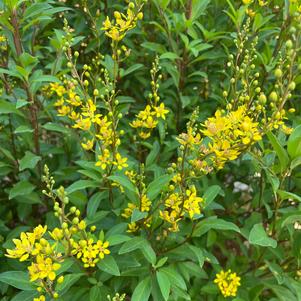
|
Golden ThryallisBotanical Name: Galphimia glauca 'Rain of Gold'
Golden Thryallis is a semi-evergreen to deciduous shrub prized for its bright yellow, star-shaped flowers that appear from late spring through fall. Though not a Texas native, it is well-adapted to Central and South Texas thanks to its heat tolerance, drought resistance, and long bloom season. The fine-textured foliage and upright growth habit make it an excellent choice for foundation plantings, low hedges, or accent borders in full sun landscapes. It prefers well-drained soils and grows best in full sun, where it will flower most profusely. Golden Thryallis tolerates both acidic and alkaline soils, as long as they are well draining. Once established, it is highly drought-tolerant and deer-resistant, and rarely troubled by pests or disease. It typically reaches 3 to 6 feet tall and wide, depending on climate and pruning. When planting in groups, space plants 3 to 5 feet apart. In USDA Zones 8b–11, it is root hardy and may die back in hard freezes but will resprout in spring. In colder parts of Central to north Texas, it's often treated as a deciduous perennial. Prune lightly in early spring to shape and remove freeze damage. Mulching at the base before a hard freeze can help protect the crown. [ More Info ]
|
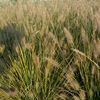
|
Grass, Dwarf HamelnBotanical Name: Pennisetum alopecuroides 'Hameln'
Dwarf Hameln Grass is a compact, clump-forming ornamental grass known for its fine-textured foliage and soft, bottlebrush-like flower spikes. A smaller cultivar of Fountain Grass, it offers a refined appearance while maintaining the same graceful arching habit. This grass thrives in Texas landscapes, providing year-round interest with its green summer foliage, tan seed heads in fall, and golden hues in winter before dormancy. It is non-toxic and generally avoided by deer, making it a low-maintenance addition to gardens and commercial landscapes alike. Ideal for borders, mass plantings, and container use, Dwarf Hameln Grass performs best in full sun to partial shade. It tolerates a variety of soil conditions but thrives in well-draining soils, whether they are neutral, acidic, or slightly alkaline. It handles occasional drought but benefits from supplemental watering in extreme heat. While adaptable to Texas’s varying climates, it does not tolerate extended periods of poor drainage or heavy clay. The soft, feathery plumes emerge in late summer, transitioning from pale tan to golden brown, adding visual appeal well into winter. This compact grass typically reaches a mature height of 18 to 24 inches and a width of 24 to 30 inches. When planting as a hedge or groundcover, space plants 18 to 24 inches apart for a full, uniform look. Its rounded shape and elegant movement in the breeze make it an excellent choice for foundation plantings, mixed perennial beds, and erosion control on slopes. In winter, Dwarf Hameln Grass enters dormancy and should be cut back in late winter to early spring before new growth begins. Trimming the foliage to about 4-6 inches will promote fresh, healthy shoots. It is hardy in USDA Zones 5-9, making it a reliable choice for most of Texas, except for the coldest northern regions where it may require extra protection during extreme freezes. [ More Info ]
|
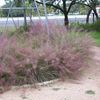
|
Grass, Gulf MuhlyBotanical Name: Muhlenbergia capillaris 'Ruby'
Texas native dwarf ornamental clumping grass with glossy green foliage that becomes nearly hidden under the very attractive pink-red flowers in the late summer that almost become a haze over the entire plant, lasting up to a month. An outstanding choice for massings. Will grow back after a freeze and return in the spring. Require well drained soils, and will suffer if left in areas with standing water. It is not required, however it’s recommended to cut back all dead foliage before spring solely for aesthetic reasons. 'Regal Mist' was the cultivar sold before 2025, thereafter we changed to 'Ruby' [ More Info ]
|
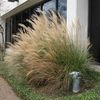
|
Grass, MuhlyBotanical Name: Muhlenbergia lindheimeri
Texas native clump forming grass that is an ideal choice for an accent or summer screen. The blue-green leaves compliment the flower plumes that emerge slightly purple, then turning silvery-gray. Lindheimer is a fast grower and could possibily benefit from a pruning in early August before blooming, but not neccessary. Requires well drained soils, and will suffer if left in areas with standing water. It is not required, however it’s recommended to cut back all dead foliage before spring solely for aesthetic reasons. [ More Info ]
|
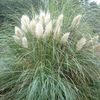
|
Grass, Pampas DwarfBotanical Name: Cortaderia selloana 'Pumila'
Dwarf Pampas Grass is a compact ornamental grass that offers the dramatic plumes of standard pampas grass in a more manageable size. Its graceful, arching foliage and creamy-white flower plumes make it a stunning focal point in Texas landscapes. Blooming from late summer to fall, the feathery plumes persist into winter, adding seasonal interest. While not native to Texas, it thrives in the region’s hot, dry conditions and is a popular choice for low-maintenance gardens. This dwarf variety is highly adaptable, tolerating a wide range of soils, including acidic and alkaline types, as long as they are well-draining. It is extremely drought-tolerant once established but benefits from occasional deep watering in prolonged dry spells. Deer-resistant and non-toxic, it is a great addition to wildlife-friendly landscapes, attracting birds that use the plumes for nesting material. Dwarf Pampas Grass grows to 4-6 feet tall and 3-5 feet wide, making it ideal for mass plantings, borders, and erosion control on slopes. When planting in groups, spacing of 4-5 feet apart allows for full, natural growth. Compared to standard pampas grass, ‘Pumila’ requires less pruning and is easier to maintain in smaller spaces. In USDA Zones 7-10, it remains semi-evergreen, though in colder regions, it may experience winter dieback. To protect it from harsh freezes, cut back foliage in late winter before new growth emerges and apply a layer of mulch around the base for insulation. [ More Info ]
|
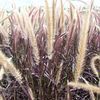
|
Grass, Purple FountainBotanical Name: Pennisetum setaceum 'Atrosanguineum'
Purple Fountain Grass is a showy ornamental grass prized for its striking burgundy-purple foliage and arching plumes of soft, feathery flowers. Though native to Africa and the Middle East, this warm-season grass adapts well to Texas landscapes, particularly in USDA Zones 9 through 11, where it is perennial. In cooler zones, it is often treated as an annual. It grows to a mature height of 3 to 5 feet and spreads 2 to 4 feet, creating a dramatic focal point in borders, mass plantings, or container gardens. Purple Fountain Grass thrives in full sun and prefers well-drained soils, tolerating both slightly acidic and alkaline conditions. This ornamental grass adds texture, movement, and year-round interest to the landscape with its rich color and graceful form. Its soft, fuzzy plumes appear in late spring to early summer and persist into the fall, enhancing its visual appeal. Purple Fountain Grass is drought-tolerant once established, making it a reliable choice for xeriscapes and low-maintenance gardens. Additionally, it is deer-resistant, as its tough, fibrous foliage is unpalatable to most wildlife. Space plants 2 to 3 feet apart for a natural look or slightly closer for denser groupings. While non-toxic, its sharp-edged blades may cause minor skin irritation if handled without gloves. Purple Fountain Grass works beautifully in contemporary landscapes, mixed perennial beds, or as a striking accent plant in decorative pots. It also pairs well with other heat-tolerant plants like lantanas, salvias, or Blackfoot daisies. In regions with regular freezing temperatures, Purple Fountain Grass is not frost-hardy and will die back in winter. Treat it as an annual, or dig up and overwinter it indoors in containers. Alternatively, collect seeds in the fall to propagate new plants the following season. [ More Info ]
|

|
Green Flax LilyBotanical Name: Dianella tasmanica
The olive green leaves are smaller than the variegated cultivar,and , provides a solid green small baririer or mass planting. Small blue flowers appear in the spring, followed by small dark blue berry fruits that are reportedly poisonous. Can tolerate full sun, however thrives in morning sun and filtered afternoon shade. Once established, is somewhat drought tolerant. [ More Info ]
|
